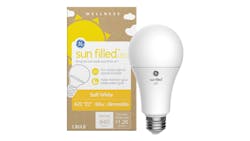GE Lighting introduces ‘sun filled’ LED A21 and BR30 replacement lamps (UPDATED)
GE Lighting, a Savant company, has announced new LED-based retrofit lamps that the company refers to as GE sun filled, and that deliver premium performance relative to many of the solid-state lighting (SSL) products on the market. Initially, the technology is available in a 60W-equivalent A21 lamp that delivers 800 lm, and in a 65W-equivalent BR30 reflector lamp that delivers 700 lm. The products deliver 97 CRI which is akin to excellent color rendition, especially relative to the bulk of the LED-based replacement lamps on the market.
GE Lighting said that the retrofit lamps further eliminate the blue peak that you typically find in the spectral power distribution (SPD) of most SSL products. The vast majority of SSL products use LED sources that are based on a 450-nm blue pump. Such an energy peak is not found in the near-uniform SPD of the sun or even the incandescent lamp.
The lack of a blue peak narrowed the list of LEDs that might be integrated in the new lamps, although GE Lighting didn’t initially reveal that information. But the GE sun filled messaging provided a clue. The lamps use Seoul Semiconductor SunLike LEDs that we first covered at launch back in 2017. The LEDs are based on a violet pump rather than a blue pump. And the design is based on a three-phosphor mix originally developed by Toshiba Materials.
The SPD of the new GE Lighting lamps is more uniform than typical LED-based lamps. Moreover, the enhanced phosphor design results in improved rendering of reds. The new lamps are specified to deliver an R9 CRI value of 80+. You can see the impact of the red phosphor in the SPD diagram included with the article linked above.
GE Lighting also touted the elimination of the blue peak to enabling better sleep at night for people living with such lighting at night. It’s long been discussed that blue spectral energy can suppress melatonin production and delay sleep. The latest research, however, reveals peak circadian sensitivity to be around the 480-nm range. Still, 450-nm energy can impact the circadian system, although not to the degree once thought.
Without question, the new lamps would improve light quality in a residential setting relative to most of the home lighting products on the market. Consumers will pay a bit more for that quality. GE Lighting says the retrofit lamps will sell in the $15 range. They will be offered in 5000K-CCT daylight and 2700K-CCT soft-white versions. GE Lighting said Lowe’s stores in California and Nevada already have the lamps in stock and that they are available at Amazon.
The GE Lighting brand has a long history of offering both mainstream lamps and premium options. For example, all the way back in 2013, GE Lighting announced the Reveal family of BR30 and A-lamps with 90 CRI performance. The Reveal brand was the identifier for the premium products.
Of course, a lot has changed in the world of GE and lighting since 2013. Next month will mark one year since GE sold the GE Lighting business to Savant Systems. GE had previously sold off the GE Current commercial lighting business to American Industrial Partners. Savant, meanwhile, embraces the GE heritage, at times touting the intellectual property (IP) it holds under the acquisition terms, and other times seems anxious to transition to new brands. Early this year, for example, we reported that Savant was moving away from the C by GE brand for connected lighting products to Savant’s Cync brand.
LEDs Magazine chief editor MAURY WRIGHT is an electronics engineer turned technology journalist, who has focused specifically on the LED & Lighting industry for the past decade.
*Updated Apr. 20, 2021 12:36 PM for wavelength clarification.
For up-to-the-minute LED and SSL updates, why not follow us on Twitter? You’ll find curated content and commentary, as well as information on industry events, webcasts, and surveys on our LinkedIn Company Page and our Facebook page.

Maury Wright | Editor in Chief
Maury Wright is an electronics engineer turned technology journalist, who has focused specifically on the LED & Lighting industry for the past decade. Wright first wrote for LEDs Magazine as a contractor in 2010, and took over as Editor-in-Chief in 2012. He has broad experience in technology areas ranging from microprocessors to digital media to wireless networks that he gained over 30 years in the trade press. Wright has experience running global editorial operations, such as during his tenure as worldwide editorial director of EDN Magazine, and has been instrumental in launching publication websites going back to the earliest days of the Internet. Wright has won numerous industry awards, including multiple ASBPE national awards for B2B journalism excellence, and has received finalist recognition for LEDs Magazine in the FOLIO Eddie Awards. He received a BS in electrical engineering from Auburn University.






